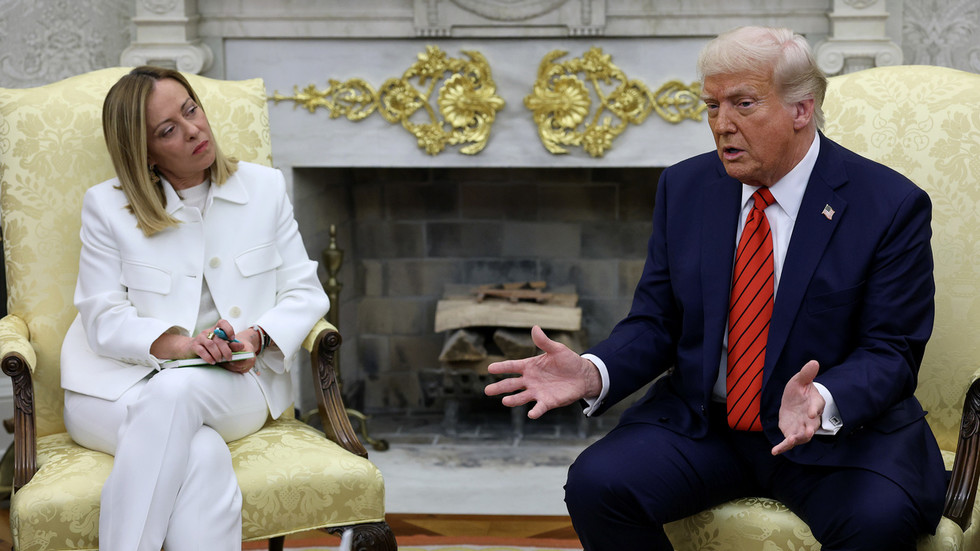It's just over a month since the Chinese Foreign Ministry spokesman Lin Jian took the podium in Beijing in response to the United States increasing tariffs on his country to 20%.
"If the United States persists in waging a tariff war, a trade war or any other kind of war, the Chinese side will fight them to the bitter end," he said on March 4.
If that was the kind of rhetoric being employed when the rate was 20%, few can now doubt that the US and China are locked in a serious trade war given that the US tariff rate soared to more than 100% overnight.
Neither side appears to have any intention of stepping down. With Chinese rates already at more than 55% and likely to increase sharply in response to Donald Trump's latest hike, the global economy is braced for a potentially hugely damaging economic conflict.
What is a trade war?
A trade war is an economic conflict in which countries implement and increase tariffs and other nontariff barriers against each other. It typically arises from extreme economic protectionism and usually features so-called tit-for-tat measures, where each side increase tariffs in response to each other.
Trade disputes and full-blown trade wars have occurred throughout history. In the 17th century, many actual wars such as the First and Second Anglo-Dutch Wars were caused by disputes over trade, while the First Opium War between the British Empire and China in the 19th century was also caused by a trade dispute.
Trump's tariffs: A risky bet?
Several trade wars have taken place through the past two centuries, sometimes focusing on specific products, at other times focusing on the entire trade between countries and economic blocs.
Historically, many trade wars and disputes have been resolved through dispute resolution, brokered by bodies such as the World Trade Organization (WTO). Free trade deals and agreements can also end a trade war.
A major turning point in trade conflict resolution was the General Agreement on Tariffs and Trade (GATT) — a legal framework agreed upon in 1947 which aimed to cut tariffs and promote international trade.
How big is this one?
Although the US-China trade war has reached an unprecedented level of escalation this week, it is effectively ongoing since Trump's first term.
In January 2018, his administration set tariffs on Chinese imports, leading to retaliation from Beijing. Although an agreement was struck between the countries in 2020, most tariffs remained in place until the latest escalations.
Trade in goods between China and the US was around $585 billion (€530 billion) in 2024. China has a huge trade surplus with the US, meaning it exports far more to the US than it imports from there.
In 2024, the US imported around $440 billion worth of goods and services from China, compared to $145 billion in the other direction.
Estimates vary, but many economists agree that the new US tariff rate on China is 104%. Chinese tariffs in the opposite direction are estimated at around 56% but that figure is expected to increase as retaliation continues.
 During Donald Trump's first presidency he got along reasonably well with Chinese President Xi JinpingImage: Kevin Lamarque/REUTERS
During Donald Trump's first presidency he got along reasonably well with Chinese President Xi JinpingImage: Kevin Lamarque/REUTERSIn terms of nontariff barriers, China has levelled export bans on rare earths and has begun an antitrust probe on the Chinese subsidiary of US chemical company DuPont.
While tariff rates could still rise dramatically on both sides, so too could nontariff barriers such as export bans and investment restrictions.
Beijing could take retaliatory measures against US companies with operations in China, such as Apple. It has already began anti-monopoly probes on tech groups Google and Nvidia. It could also seek to bar Chinese companies from investing in the US.
On the US side, Trump has made it clear he is willing to keep increasing tariffs. He could also further limit Chinese companies from investing in the US and could restrict US companies from investing in strategic technologies in China, aimed at thwarting Beijing's technological development.
Will there be other trade wars?
On April 8, Trump's so-called "reciprocal tariffs" came into effect at varying rates against scores of countries around the world, with blanket rates of 10% already imposed against all countries.
While some foreign leaders have sought to negotiate with the White House, the risk of multiple trade wars is significant. That's especially the case given that Trump and his economic advisors have said that countries lowering tariffs against the US is not enough, and that they expect balanced trade as well as other concessions.
The EU Commission said on Monday it had offered a "zero-for-zero" tariff deal to avert a trade war. But it has also proposed its first retaliatory tariffs at 25% on a range of US imports in response to Trump's steel and aluminium tariffs. It has not yet come up with a formal response to the 20% reciprocal tariffs Trump put in place against the EU.
EU considers response to Trump trade tariffs
While the EU response has been restrained so far, it is expected to produce a larger set of countermeasures by the end of April. The bloc's trade commissioner, Maros Sefcovic, said the EU is keeping all its options on the table. That includes its Anti-Coercion Instrument (ACI) — a suite of measures which could include limiting US investments in Europe and targetting US services, including tech companies.
How might it all end?
This is anyone's guess. The first round of Trump tariffs on China in 2018 led to negotiations and a so-called Phase One trade agreement. However tariff rates between the countries were much higher after the agreement than they were before the dispute began.
Some countries may secure deals which may lead to lower tariff rates. For example, Trump said on Monday that Japan was sending a team to negotiate, suggesting Tokyo was first in line for a preferential deal.
However, when it comes to China, signs of a swift or sweet deal seem slim. Both sides see themselves as having the upper hand, given the size of their economies, and neither currently shows any sign of backing down.
Edited by: Uwe Hessler

 1 week ago
7
1 week ago
7









